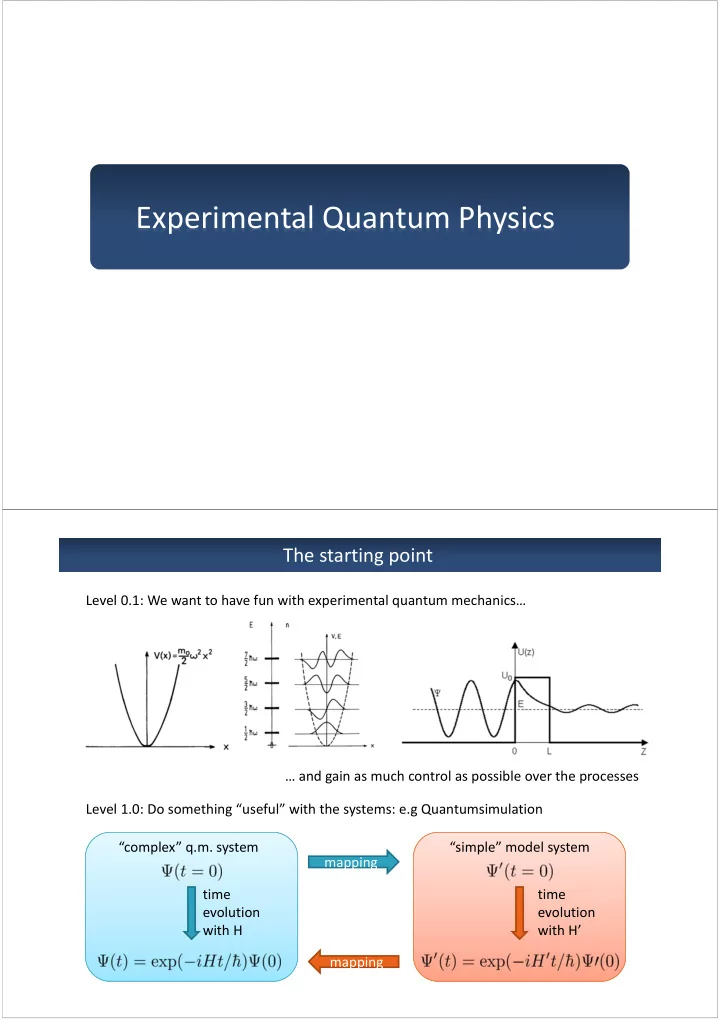

Experimental Quantum Physics The starting point Level 0.1: We want to have fun with experimental quantum mechanics… … and gain as much control as possible over the processes Level 1.0: Do something “useful” with the systems: e.g Quantumsimulation “complex” q.m. system “simple” model system mapping time time evolution evolution with H with H’ mapping
We need a quantum lab! There are various ways to generate that, we will only consider neutral atoms One of the main ingredients of the quantum laboratory Some properties of BEC Bose Einstein Condensate Macroscopic occupation of one quantum • mechanical level Coherent matter wave : • v d matter wave interference T>>T c Interaction between atoms dominates • ground state as well as dynamical behavior dB T~T c Excellent control over all (most,…) • experimental parameters Theoretical prediction 1924/5: A. Einstein and S. N. Bose First experimental realization 1995 T=0 BEC in dilute alkali gases: E. A. Cornell, W. Ketterle and C. E. Wieman
Experimental realization of BEC 2D ‐ MOT 3D ‐ MOT Molasses Magnetic trap Evaporation Laser cooling n=10 4 cm ‐ 3 n=10 10 cm ‐ 3 n=10 14 cm ‐ 3 T=300K T=10 ‐ 100µK T=100nK Experimental realization of BEC 2D ‐ MOT 3D ‐ MOT Molasses Magnetic trap Evaporation Laser cooling n=10 4 cm ‐ 3 n=10 10 cm ‐ 3 n=10 14 cm ‐ 3 T=10 ‐ 100µK T=100nK T=300K
Experimental realization of BEC Magnetic trap Evaporation 2D ‐ MOT 3D ‐ MOT Molasses Dipol trap Particle number from 10 10 down to 10 6 n=10 10 cm ‐ 3 n=10 4 cm ‐ 3 n=10 14 cm ‐ 3 n=10 14 cm ‐ 3 T=300K T=10 ‐ 100µK T=100nK T=100nK Experimental realization of BEC Dipole trap 2D ‐ MOT 3D ‐ MOT Molasses Magnetic trap Evaporation Isotropic trap Elongated trap n=10 14 cm ‐ 3 n=10 4 cm ‐ 3 n=10 10 cm ‐ 3 T=300K T=10 ‐ 100µK T=100nK
Experimental realization of BEC Magnetic trap Evaporation 2D ‐ MOT 3D ‐ MOT Molasses Particle number from 10 10 down to 10 6 n=10 10 cm ‐ 3 n=10 4 cm ‐ 3 n=10 14 cm ‐ 3 n=10 14 cm ‐ 3 T=300K T=10 ‐ 100µK T=100nK T=100nK One, two,…more… Exploiting the different quantum statistics Degenerate Bose gas Degenerate Fermi gas Various combinations: Bose – Fermi mixtures • Fermionic Molecules Mixtures of spin • components Bosonic molecules
Physics with Bose ‐ Einstein condensates Ok, so we have a fancy quantum mechanical system with quite some control, but what to simulate with it? Collective excitations Multi component BEC Hamburg Molecular BEC Ketterle, MIT BEC Atom Laser Grimm, Innsbruck Bloch, Munich Low ‐ dimensional systems Optical lattices Greiner, MPQ Paredes, MPQ Non ‐ exclusive choice of applications Motivation and Applications Benefits of OL Almost arbitrary lattice geometries Solid state models • • can be realized using interfering laser beams Quantum magnetism • No lattice imperfections • No impurity atoms (only if desired) • Cold chemistry • Continuous tuning of lattice • parameters Atomic clocks Almost perfect model system • • Quantum information • Exotic super conductors •
Back to some basic atomic physics Atom |�� The two systems couple together via Light electric dipole transitions � �� � ����� Transition matrix element |�� |�, �, � � � � �� � � Coupling of the two systems leads to a shift of the energy levels |�� The shift is proportional to � ~ ���� ∆�~ � ∙ � �� � � In words: The (potential) energy of the |�� respective atomic level depends on the intensity distribution of the light field Atoms in an off ‐ resonant laser beam Time Induced Neutral Atom dependent dipole electric field moment + → Induced dipole moment interacts with the electric field Force onto the atom
Periodic potentials Optical dipole potential: Potential is proportional to the intensity distribution of the light field Sign depends on wavelength of the laser (usually “ ‐ “) Simplest case: 1D lattice by retro reflecting a laser beam Optical lattices: Light crystals Periodic potential Optical lattice : laser interference Solid: ionic crystal Laser Laser Potential for polarizable atoms Potential for electrons Band structure Lattice beam intensity (lattice depth) Optical lattices: • No phonons (Lattice structure is rigid) • No localized impurities or defects • Highly controllable ! Kin. energy Tunnel rate Int. energy Interactions 16
Ways to measure what‘s going on Direct site resolved Imaging after release from lattice imaging Laser Laser Ott lab In ‐ situ momentum distribution is converted into real space due to free expansion CCD camera Resonant Imaging Beam Weiss, Greiner, Bloch and other labs Tuneable lattice geometries Most simple case: make the mutually orthogonal sets of beams independent �,� cos � � � � �� �,� cos � � � � �,� cos � � � � �� V x, y, z ~ �� Greiner et al.
Dimensionality and Geometry Kagomé Honeycomb Triangular Jo et al.,Phys. Rev. Lett. 108, 045305 (2012) Soltan ‐ Panahi et al., Nature Physics 7, 434 Becker et al., New J. Phys. 12, 065025 (2010) (2011) Tarruell et al., Nature 483, 302 (2012) Overview on novel geometries: Windpassinger & Sengstock Rep. Prog. Phys. 76, 086401 (2013) Toolbox of tunable lattice geometries Double well lattices Variable geometries T. Esslinger (ETH) D. Stamper ‐ Kurn (Berkeley) e.g. J. Porto (NIST), A. Hemmerich (Hamburg), K. Sengstock I. Bloch (MUC), Windpassinger & Sengstock (Hamburg) Rep. Prog. Phys. 76, 086401 (2013) M. Weitz (Bonn)
Recommend
More recommend